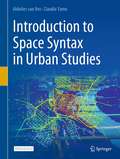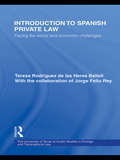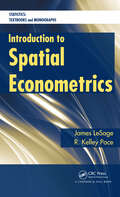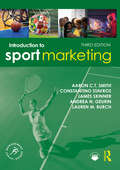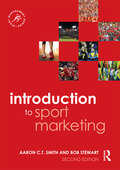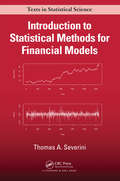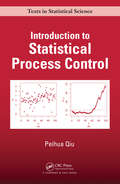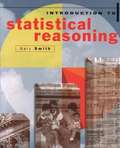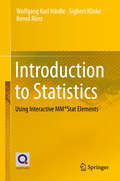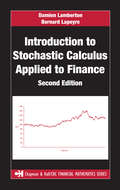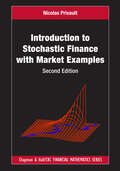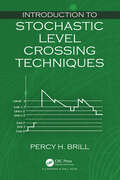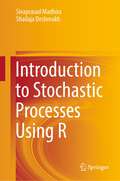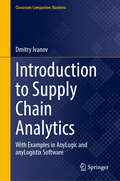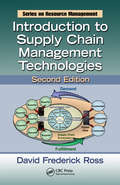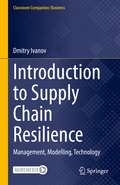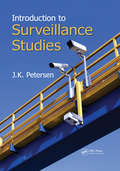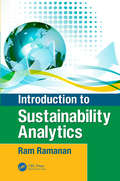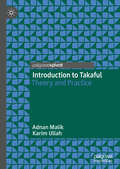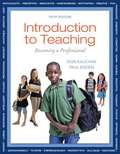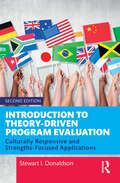- Table View
- List View
Introduction to Space Syntax in Urban Studies
by Claudia Yamu Akkelies van NesThis open access textbook is a comprehensive introduction to space syntax method and theory for graduate students and researchers. It provides a step-by-step approach for its application in urban planning and design. This textbook aims to increase the accessibility of the space syntax method for the first time to all graduate students and researchers who are dealing with the built environment, such as those in the field of architecture, urban design and planning, urban sociology, urban geography, archaeology, road engineering, and environmental psychology. Taking a didactical approach, the authors have structured each chapter to explain key concepts and show practical examples followed by underlying theory and provided exercises to facilitate learning in each chapter. The textbook gradually eases the reader into the fundamental concepts and leads them towards complex theories and applications. In summary, the general competencies gain after reading this book are:– to understand, explain, and discuss space syntax as a method and theory;– be capable of undertaking various space syntax analyses such as axial analysis, segment analysis, point depth analysis, or visibility analysis;– be able to apply space syntax for urban research and design practice;– be able to interpret and evaluate space syntax analysis results and embed these in a wider context;– be capable of producing new original work using space syntax.This holistic textbook functions as compulsory literature for spatial analysis courses where space syntax is part of the methods taught. Likewise, this space syntax book is useful for graduate students and researchers who want to do self-study. Furthermore, the book provides readers with the fundamental knowledge to understand and critically reflect on existing literature using space syntax.
Introduction to Spanish Private Law: Facing the Social and Economic Challenges (UT Austin Studies in Foreign and Transnational Law)
by Teresa Rodriguez de las Heras BallellThe topics addressed in this book have traditionally been covered in separate publications on civil and commercial law. This dualism of regimes has made it difficult for students and professionals alike to comprehend Spanish private law as a whole. In the past this has led to inefficient duplication of explanations, gaps in key areas and an altogether fragmented picture. Introduction to Spanish Private Law presents a consolidated, modern, and realistic image of today’s Spanish private legal system. It combines both civil and commercial law and integrates them in the same book, making the overall subject far more accessible to readers. This united approach results in a more logical and efficient process of learning. Finally the issues that are addressed reflect the reality of today’s economic and legal scene. This book attempts to provide the readers with the necessary legal instruments to tackle the real problems arising from a globalized modern society. The general principles in this book are presented from a practical point of view that emanates from the authors’ conception of a legal system as an instrument to solve social problems in accordance with a set of principles, values and aims.
Introduction to Spatial Econometrics (Statistics: A Series of Textbooks and Monographs)
by James LeSage Robert Kelley PaceAlthough interest in spatial regression models has surged in recent years, a comprehensive, up-to-date text on these approaches does not exist. Filling this void, Introduction to Spatial Econometrics presents a variety of regression methods used to analyze spatial data samples that violate the traditional assumption of independence between observat
Introduction to Sport Marketing: Second Edition (Sport Management Series)
by Constantino Stavros James Skinner Andrea N. Geurin Aaron C.T. Smith Lauren M. BurchNow in a fully revised and updated third edition, Introduction to Sport Marketing is a clear, straightforward, and concise introduction to the theory and practice of sport marketing, and the only sport marketing textbook you will ever need.Built around a step-by-step framework for developing effective sport marketing plans, and full of real-world, international cases, data, and examples, the text helps students to develop the essential skills and subject knowledge required to thrive in today’s fast-paced sport industry. It covers sport marketing at all levels, from grassroots and community sport to international mega-events, and across all sectors from professional sport to public and not-for-profit organisations. Leading the reader through the marketing process, from analysis and setting a strategy to planning the marketing mix, implementation, and evaluation, the text introduces the products, services, distribution channels, and stakeholders that generate value, including brands, merchandise and licensed products, players and athletes, leagues and franchises, and events. This new edition includes expanded coverage of cutting-edge topics, including social media, digital sport marketing, esports, the social impact of sport, ‘sportwashing’ and soft power, innovation and fast prototyping, consumer psychology, and diversity and equity. It includes useful features throughout, from review questions to guides to further resources.This is an essential textbook for any sport marketing course taken as a part of a degree programme in sport management, sport marketing, sport business, sport development, or business, management, and marketing.
Introduction to Sport Marketing: Second edition (Sport Management Series)
by Bob Stewart Aaron C.T. SmithIntroduction to Sport Marketing is an accessible and engaging introduction to key concepts and best practice in sport marketing. Aimed at students with little or no prior knowledge of marketing, the book outlines a step-by-step framework for effective sport marketing, from conducting market analysis and developing a strategy, through to detailed planning and implementation. The book has a wider scope than other sport marketing textbooks, recognising that students are just as likely to have to employ their marketing skills in community sport or the not-for-profit sector as in professional sport, and therefore represents the most realistic and useful sport marketing text currently available. Now in a fully revised and updated second edition, the book has expanded coverage of digital and social media, product innovation, services and relationship marketing, and key contemporary issues such as social responsibility and sustainability. It features a much wider range of international cases and examples, covering North America, Europe, and the vibrant and rapidly developing sport markets in Asia-Pacific, the Middle East and Latin America. Every chapter includes a range of useful features to help the reader to engage with fundamental principles and applied practice, such as problem-solving exercises and review questions. Introduction to Sport Marketing is an essential textbook for any degree-level sport marketing course.
Introduction to Statistical Methods for Financial Models (Chapman & Hall/CRC Texts in Statistical Science)
by Thomas A SeveriniThis book provides an introduction to the use of statistical concepts and methods to model and analyze financial data. The ten chapters of the book fall naturally into three sections. Chapters 1 to 3 cover some basic concepts of finance, focusing on the properties of returns on an asset. Chapters 4 through 6 cover aspects of portfolio theory and the methods of estimation needed to implement that theory. The remainder of the book, Chapters 7 through 10, discusses several models for financial data, along with the implications of those models for portfolio theory and for understanding the properties of return data. The audience for the book is students majoring in Statistics and Economics as well as in quantitative fields such as Mathematics and Engineering. Readers are assumed to have some background in statistical methods along with courses in multivariate calculus and linear algebra.
Introduction to Statistical Process Control (Chapman & Hall/CRC Texts in Statistical Science)
by Peihua QiuA major tool for quality control and management, statistical process control (SPC) monitors sequential processes, such as production lines and Internet traffic, to ensure that they work stably and satisfactorily. Along with covering traditional methods, Introduction to Statistical Process Control describes many recent SPC methods that improve upon
Introduction to Statistical Reasoning
by Gary N. SmithThis textbook is intended for an introductory statistics course that will help students to develop their statistical reasoning. This book provides hundreds of interesting and relevant examples, and discusses not only the uses but also the abuses of statistics. These examples show how statistical reasoning can be used correctly to answer important questions and it also exposes the errors--accidental or intentional--that people often make with statistics. The book has special features of: Have You Ever Wondered?, How To Do It Boxes, Student Projects, Real Data, and Technology.
Introduction to Statistics: Using Interactive MM*Stat Elements
by Wolfgang Karl Härdle Sigbert Klinke Bernd RönzThis book covers all the topics found in introductory descriptive statistics courses, including simple linear regression and time series analysis, the fundamentals of inferential statistics (probability theory, random sampling and estimation theory), and inferential statistics itself (confidence intervals, testing).Each chapter starts with the necessary theoretical background, which is followed by a variety of examples. The core examples are based on the content of the respective chapter, while the advanced examples, designed to deepen students’ knowledge, also draw on information and material from previous chapters.The enhanced online version helps students grasp the complexity and the practical relevance of statistical analysis through interactive examples and is suitable for undergraduate and graduate students taking their first statistics courses, as well as for undergraduate students in non-mathematical fields, e.g. economics, the social sciences etc.
Introduction to Stochastic Calculus Applied to Finance (Chapman and Hall/CRC Financial Mathematics Series)
by Damien Lamberton Bernard LapeyreSince the publication of the first edition of this book, the area of mathematical finance has grown rapidly, with financial analysts using more sophisticated mathematical concepts, such as stochastic integration, to describe the behavior of markets and to derive computing methods. Maintaining the lucid style of its popular predecessor, this concise and accessible introduction covers the probabilistic techniques required to understand the most widely used financial models. Along with additional exercises, this edition presents fully updated material on stochastic volatility models and option pricing as well as a new chapter on credit risk modeling. It contains many numerical experiments and real-world examples taken from the authors' own experiences. The book also provides all of the necessary stochastic calculus theory and implements some of the algorithms using SciLab. Key topics covered include martingales, arbitrage, option pricing, and the Black-Scholes model.
Introduction to Stochastic Finance with Market Examples (Chapman and Hall/CRC Financial Mathematics Series)
by Nicolas PrivaultIntroduction to Stochastic Finance with Market Examples, Second Edition presents an introduction to pricing and hedging in discrete and continuous-time financial models, emphasizing both analytical and probabilistic methods. It demonstrates both the power and limitations of mathematical models in finance, covering the basics of stochastic calculus for finance, and details the techniques required to model the time evolution of risky assets. The book discusses a wide range of classical topics including Black–Scholes pricing, American options, derivatives, term structure modeling, and change of numéraire. It also builds up to special topics, such as exotic options, stochastic volatility, and jump processes. New to this Edition New chapters on Barrier Options, Lookback Options, Asian Options, Optimal Stopping Theorem, and Stochastic Volatility Contains over 235 exercises and 16 problems with complete solutions available online from the instructor resources Added over 150 graphs and figures, for more than 250 in total, to optimize presentation 57 R coding examples now integrated into the book for implementation of the methods Substantially class-tested, so ideal for course use or self-study With abundant exercises, problems with complete solutions, graphs and figures, and R coding examples, the book is primarily aimed at advanced undergraduate and graduate students in applied mathematics, financial engineering, and economics. It could be used as a course text or for self-study and would also be a comprehensive and accessible reference for researchers and practitioners in the field.
Introduction to Stochastic Level Crossing Techniques
by Percy H. BrillIntroduction to Stochastic Level Crossing Techniques describes stochastic models and their analysis using the System Point Level Crossing method (abbreviated SPLC or LC). This involves deriving probability density functions (pdfs) or cumulative probability distribution functions (cdfs) of key random variables, applying simple level-crossing limit theorems developed by the author. The pdfs and/or cdfs are used to specify operational characteristics about the stochastic model of interest. The chapters describe distinct stochastic models and associated key random variables in the models. For each model, a figure of a typical sample path (realization, i.e., tracing over time) of the key random variable is displayed. For each model, an analytic (Volterra) integral equation for the stationary pdf of the key random variable is created−by inspection of the sample path, using the simple LC limit theorems. This LC method bypasses a great deal of algebra, usually required by other methods of analysis. The integral equations will be solved directly, or computationally. This book is meant for students of mathematics, management science, engineering, natural sciences, and researchers who use applied probability. It will also be useful to technical workers in a range of professions. Key Features: A description of one representative stochastic model (e.g., a single-server M/G/1 queue; a multiple server M/M/c queue; an inventory system; etc.) Construction of a typical sample path of the key random variable of interest (e.g., the virtual waiting time or workload in queues; the net on-hand inventory in inventory systems; etc.) Statements of the simple LC theorems, which connect the sample-path upcrossing and downcrossing rates across state-space levels, to simple mathematical functions of the stationary pdf of the key random variable, at those state-space levels Creation of (usually Volterra) integral equations for the stationary pdf of the key random variable, by inspection of the sample path Direct analytic solution of the integral equations, where feasible; or, computational solutions of the integral equations Use of the derived stationary pdfs for obtaining operational characteristics of the model
Introduction to Stochastic Processes Using R
by Shailaja Deshmukh Sivaprasad MadhiraThis textbook presents some basic stochastic processes, mainly Markov processes. It begins with a brief introduction to the framework of stochastic processes followed by the thorough discussion on Markov chains, which is the simplest and the most important class of stochastic processes. The book then elaborates the theory of Markov chains in detail including classification of states, the first passage distribution, the concept of periodicity and the limiting behaviour of a Markov chain in terms of associated stationary and long run distributions. The book first illustrates the theory for some typical Markov chains, such as random walk, gambler's ruin problem, Ehrenfest model and Bienayme-Galton-Watson branching process; and then extends the discussion when time parameter is continuous. It presents some important examples of a continuous time Markov chain, which include Poisson process, birth process, death process, birth and death processes and their variations. These processes play a fundamental role in the theory and applications in queuing and inventory models, population growth, epidemiology and engineering systems. The book studies in detail the Poisson process, which is the most frequently applied stochastic process in a variety of fields, with its extension to a renewal process. The book also presents important basic concepts on Brownian motion process, a stochastic process of historic importance. It covers its few extensions and variations, such as Brownian bridge, geometric Brownian motion process, which have applications in finance, stock markets, inventory etc. The book is designed primarily to serve as a textbook for a one semester introductory course in stochastic processes, in a post-graduate program, such as Statistics, Mathematics, Data Science and Finance. It can also be used for relevant courses in other disciplines. Additionally, it provides sufficient background material for studying inference in stochastic processes. The book thus fulfils the need of a concise but clear and student-friendly introduction to various types of stochastic processes.
Introduction to Stockholders' Equity
by Jacob Cohen Thomas D. FieldsThe stockholders' equity section of the balance sheet illustrates details of accounting for stock offerings, common stock, and preferred stock. Accounting for dividends, both cash and stock dividends, and treasury stock is covered.
Introduction to Strategic Innovation
by Chris Trimble Vijay GovindarajanIn today's marketplace, characterized by rapid and nonlinear change, executing strategic innovation successfully has become imperative for generating sustained growth and extending the corporate life span. In this chapter, the authors describe and demystify strategic innovation.
Introduction to Supply Chain Analytics: With Examples in AnyLogic and anyLogistix Software (Classroom Companion: Business)
by Dmitry IvanovThe book offers a concise yet comprehensive introduction to supply chain analytics covering management, modeling, and technology perspectives. Designed to accompany the textbook “Global Supply Chain and Operations Management”, it addresses the topics of supply chain analytics in more depth. The book describes descriptive, predictive, and prescriptive supply chain analytics explaining methodologies, illustrating method applications with the use of training exercises, and providing numerous examples in AnyLogic and anyLogistix software. Throughout the book, numerous practical examples and short case studies are given to illustrate theoretical concepts. Along with AnyLogic and anyLogistix model development guidelines and examples, the book has two other distinct features. First, it reviews and explains novel frameworks and concepts related to data-driven decision-making and digital twins. Second, it shows how to use analytics to improve supply chain resilience.Without relying heavily on mathematical derivations, the book offers a structured presentation and explanation of major supply chain analytics techniques and principles in a simple, predictable format to make it easy to understand for students and professionals with both management and engineering backgrounds. Graduate/Ph.D. students and supply chain professionals alike would benefit from a structured and didactically-oriented concise presentation of the concepts, principles, and methods of supply chain analytics. Providing graduate students and supply chain managers with working knowledge of basic and advanced supply chain analytics, this book contributes to improving knowledge-awareness of decision-making in increasingly data-driven and digital environments. The book is supplemented by a companion website offering interactive exercises with the use of AnyLogic and anyLogistix software as well as Spreadsheet Modeling.
Introduction to Supply Chain Management Technologies (Resource Management)
by David Frederick Ross Frederick S. Weston Stephen W.It is almost impossible to conceive of the concept and practical application of supply chain management (SCM) without linking it to the enabling power of today‘s information technologies. Building upon the foundations of the first edition, Introduction to Supply Chain Management Technologies, Second Edition details the software toolsets and suites
Introduction to Supply Chain Resilience: Management, Modelling, Technology (Classroom Companion: Business)
by Dmitry IvanovThis book offers a concise yet comprehensive introduction to supply chain resilience, covering management, modeling and technology perspectives. Designed to accompany the textbook “Global Supply Chain and Operations Management” it addresses the topics of supply chain risks and resilience in more depth, describing the major features of supply chain resilience and explaining methodologies to mitigate supply chain disruptions and recover. Numerous practical examples and short case studies are provided to illustrate theoretical concepts. Without relying heavily on mathematical derivations, the book explains major concepts and methods to build and improve supply chain resilience and tackle supply chain disruption risks in a simple, uniform format to make it easy to understand for students and professionals with both management and engineering backgrounds. Graduate/PhD students and supply chain professionals alike will benefit from the structured, didactically oriented and concise presentation of the concepts, principles and methods of supply chain resilience management, modeling, and technological implementation.
Introduction to Surveillance Studies
by J.K. PetersenSurveillance is a divisive issue one might say it is inherently controversial. Used by private industry, law enforcement, and for national security, it can be a potent tool for protecting resources and assets. It can also be extremely invasive, calling into question our basic rights to freedom and privacy. Introduction to Surveillance Studies explo
Introduction to Sustainability Analytics
by Raghavan Ram RamananThe roles of corporate and public stewards and the nature of their social contract with society have been changing over the past two centuries, and those changes have accelerated in recent decades. Moreover, with increasing focus on sustainability factors from the marketplace (regulators, investors, financiers, and consumers), corporate sustainability disclosure is shifting from voluntary to vital. Corporate and public stewards are now responsible for their performance and services from cradle-to-grave: they must properly manage corporate social responsibility and integrate it into their global strategies, rather than consider it as merely a moral obligation or a risk/reputation management exercise. <P><P> Sustainability analytics, the critical link between sustainability and business strategy, helps professionals track, trend, and transform sustainability information into actionable insights across the value chain and life cycle, to enhance their sustainability performance and its disclosure. This book, Introduction to Sustainability Analytics, provides corporate and public stewards with a comprehensive understanding of how to determine which sustainability metrics are material to them and relevant to their business, and how to incorporate them into corporate strategy, resource allocation, and prioritization. Focusing on practical decision-making needs, it explains how to value and prioritize initiatives, and how to best allocate necessary resources through several real case studies and practical examples. <P><P> Features: <P><P> Examines pressing issues such as climate change, water scarcity, and environmental justice <P><P> Explains how to develop a business case and global strategy for social responsibility <P><P> Includes both corporate and public policy perspectives on sustainability economics <P><P> Covers emerging regulations on sustainability disclosure and responsible investing
Introduction to Sustainability: Road to a Better Future
by Nolberto MunierThis book develops a supporting structure for sustainable development, following a natural set of steps to reach an established goal. It provides the tools to navigate this Road to a Better Future by explaining concepts, giving ideas, proposing methods, and suggesting actions. To illustrate the utilization of techniques there are many examples, applied to a variety of activities, and to wrap up concepts, the last chapter is dedicated to the analysis of a community in search of a sustainable environment. A thematic index has been designed to help a person quickly find information on relevant topics.
Introduction to Takaful: Theory and Practice
by Karim Ullah Adnan MalikThis book provides a comprehensive account of the theory and practice of takaful, which is an Islamic alternative to insurance. The concepts are explained using real-life case studies, calculations, and exhibits to aid in reader learning and reflection. Takaful, both as an academic subject and as well as practice, is growing particularly in the world leading financial and learning hubs such as in the UK and the USA and countries with large Muslim populations in Asia, Africa, and Middle East.
Introduction to Teaching: Becoming a Professional (Fifth Edition)
by Don Kauchak Paul EggenThe best-selling case-based text, Introduction to Teaching: Becoming a Professional, sharpens its focus on issues in education in its Fifth Edition. Weaving this focus throughout every chapter with new features and chapter sections covering diversity, reform, urban education, and technology, the text ensures that prospective teachers gather all the needed information to create an up-to-date picture of the ever changing face of education. The authors take this information and bring it to life with cases, classroom examples and videos, again ensuring that the living, changing, challenging and fulfilling life of an educator is as clear as it can be.
Introduction to Theory-Driven Program Evaluation: Culturally Responsive and Strengths-Focused Applications
by Stewart I. DonaldsonIntroduction to Theory-Driven Program Evaluation provides a clear guide for practicing evaluation science, and numerous examples of how these evaluations actually unfold in contemporary practice. A special emphasis is placed how to conduct theory-driven program evaluations that are culturally responsive and strengths-focused. In this thoroughly revised new edition, author Stewart I. Donaldson provides a state-of-the art treatment of the basics of conducting theory-driven program evaluations. Each case follows a three-step model: developing program impact theory; formulating and prioritizing evaluation questions; and answering evaluation questions. The initial chapters discuss the evolution and popularity of theory-driven program evaluation, as well as step-by-step guide for culturally responsive and strengths-focused applications. Succeeding chapters provide actual cases and discuss the practical implications of theory-driven evaluation science. Reflections, challenges, and lessons learned across numerous cases from practices are discussed. The volume is of significant value to practicing evaluators, professors of introductory evaluation courses and their students, advanced undergraduate and graduate students, and serves as a text or a supplementary text for a wide range of evaluation and applied research courses. It is also of great interest to those interested in the connections between work and health, well-being, career development, human service organizations, and organizational improvement and effectiveness.
Introduction to Three-Dimensional Design: Principles, Processes, and Projects (Design Brief Ser.)
by Kimberly ElamIntroduction to Three-Dimensional Design is the first book to teach graphic design students the fundamentals of three-dimensional design through hands-on drawing and model projects. The book combines key concepts with carefully crafted exercises so students can apply three-dimensional design principles in practice. From initial sketches through experimental prototypes to the final model solutions, students will develop a deeper understanding of the often complex elements and principles of three-dimensional design.
